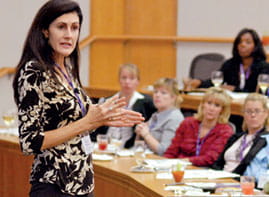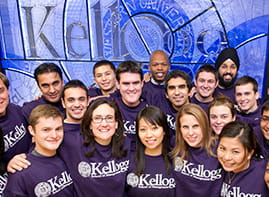In anticipation of the Jan. 11-12 Miami event, Faculty Co-Chair Mohanbir Sawhney tells why getting close to the customer is essential — particularly during an economic downturn
12/18/2008 - Shortly after portable digital music players hit the market in 1998, Apple Computer Inc. made plans to launch its own MP3 device. But rather than emulate existing products, Apple asked its customers what they wanted — and learned that they liked the idea of a portable player that was small and convenient to carry. In 2001, based on these insights, Apple unveiled a revolutionary, miniature music player called the iPod. Within three years, the company had sold more than three million of these devices, and today demand continues to surge, making the iPod a ubiquitous and iconic category leader.
Like Apple, companies are increasingly moving away from a product-centric business model in favor of one that keeps the focus on customers. On Jan. 11-12, a panel of business leaders, scholars and practitioners will share their ideas on customer-centricity at “Customer-Centric Innovation,” the latest conference in the Kellogg School’s Centennial Conference Series, launched earlier this year in honor of the school’s Centennial Celebration.
Held at the Mandarin Oriental Hotel in Miami, the conference features keynote speaker Carlos Dominguez, senior vice president, Office of the Chairman and CEO, Cisco Systems Inc., who will explore how technology can enable collaboration and innovation. Conference panelists include J. Duncan Berry, principal at Applied Iconology Inc., and Rafal Ohme, CEO of LABOratorium. Kellogg faculty participants include James Conley, Shane Greenstein and Scott Stern, who bring deep knowledge of subjects such as intellectual property rights, the innovation process, and the commercialization of technology. Pete Pizarro ’94, CEO of eLandia International, is the event’s alumni co-chair.
The conference’s faculty co-chair, Mohanbir Sawhney, McCormick Tribune Professor of Technology at the Kellogg School, is an expert on strategic marketing, innovation and new media. His research and teaching interests include marketing and media in the digital world, process-centric marketing, collaborative marketing, organic growth and network-centric innovation.
In anticipation of the conference, Sawhney shared his perspective on customer-centricity and its value to the business world today, particularly given the current U.S. recession.
Rachel Farrell: What does customer-centricity mean under ordinary market circumstances? That is, what should businesses normally be doing to engage customers and, in certain cases, get them involved in the design or marketing process?
Prof. Mohanbir Sawhney: Customer-centricity has three steps to it. Step one is developing a better understanding of customer needs and insights by getting closer to customers and engaging them in product development. The next step is using that insight to create superior products, service and value propositions, which involves segmentation and value proposition development. Step three is delivering on a customer experience that’s better than the competition.
RF: How does a customer-centric focus shift during bad market times, like now?
Prof. Sawhney: It actually becomes even more important, because there are fewer new customers. It is as much as five times as costly to acquire a new customer as it is to retain an existing customer. And when new customers become scarce and the cost of acquiring them is greater, in an economic downturn it is all more important to retain the customers you have and grow your business with the most valuable customers.
RF: Given the recession, should businesses be more focused on introducing new products or tweaking and updating old ones? Are there risks to postponing innovation, even during lean times?
Prof. Sawhney: It’s an interesting dilemma. I recommend that you do more mining than hunting, and more leveraging of existing products through extensions and adaptations, than really taking very high-risk debts at this stage with an expensive new product launch and development campaign. That said, it is important not to lose sight of the fact that this too shall pass. If you become too defensive and too incremental, you may be left out of the next cycle of growth, which shall and will come, sooner or later. It’s important not to let breakthrough innovation genes atrophy so that when the next wave of growth comes, you find yourself missing out on it.
RF: If a firm introduces a new product with breakthrough technology — in other words, a product that has never been seen before — how can the firm predict consumer demand?
Prof. Sawhney: It’s not easy to do. Most of the predictions are based on the history of similar products that have been launched. For instance, when Blu-ray players were introduced, you looked at the historical evolution of the demand for DVD players. And before that, you looked at the demand for VCRs and VHS players. But if it’s a truly new product, it is difficult to look at benchmarks. The closest you can come to it is through using an analogy as a basis for forecasting. But it does remain a combination of art and science.
RF: How does a firm leverage early adopters of technology and engage them in a way that helps the company target their product or service to a mass market?
Prof. Sawhney: What you want to do is generate buzz through word-of-mouth so that that product becomes more widely accepted. You engage with the earlier adopters — bloggers and folks who are trying to review the early products — and get them enthusiastic about the product early on. That can then affect the broader market. That’s why there’s a new phenomenon now of not just “one-to-one marketing” or “one-to-many marketing,” but “one-to-some-to-many marketing.”
RF: In what ways has the Internet changed the way that businesses gather customer insight during product development or marketing?
Prof. Sawhney: It’s done a couple of things. Now you can engage millions of customers in dialogue and do it in real time and do it very cheaply. The cost, the speed and the scale have all been enhanced by an order of magnitude. It also has done something that was not possible before: You can now get input from online communities. It’s kind of like having a focus group of 500 people. People build on each others’ ideas.
RF: In your article, “Insights into Customer Insights,” you stress that customer insights sometimes defy conventional logic. If the right business decision can initially seem like the wrong one, how can companies figure out what moves to make?
Prof. Sawhney: Well, that’s what brilliant leadership is about: having the courage of conviction to go against the crowd and see an opportunity that other people don’t. [For example, leaders at] Sony, Apple, Wal-Mart and Starbucks all questioned commercial wisdom and came up with business models and products and concepts that defied conventional thinking. For example, Michael Dell [founder and CEO of Dell Inc.] asked, “Why can’t you sell computers directly to the consumer? Why do you need a middle man?” People said that that was foolish. They couldn’t visualize people buying computers [from a Web site]. But Dell proved them wrong. That’s what great innovation is made of: keen observation of customer behavior … and the courage of conviction to stick with it, even when everyone else is telling you that you’re wrong. I like to tell my students, “On the road less traveled, there are no carpools.”






